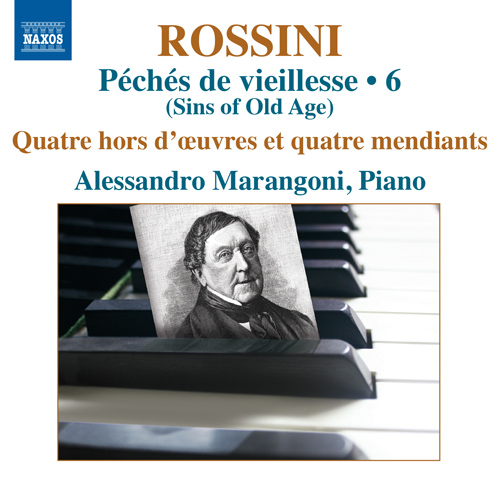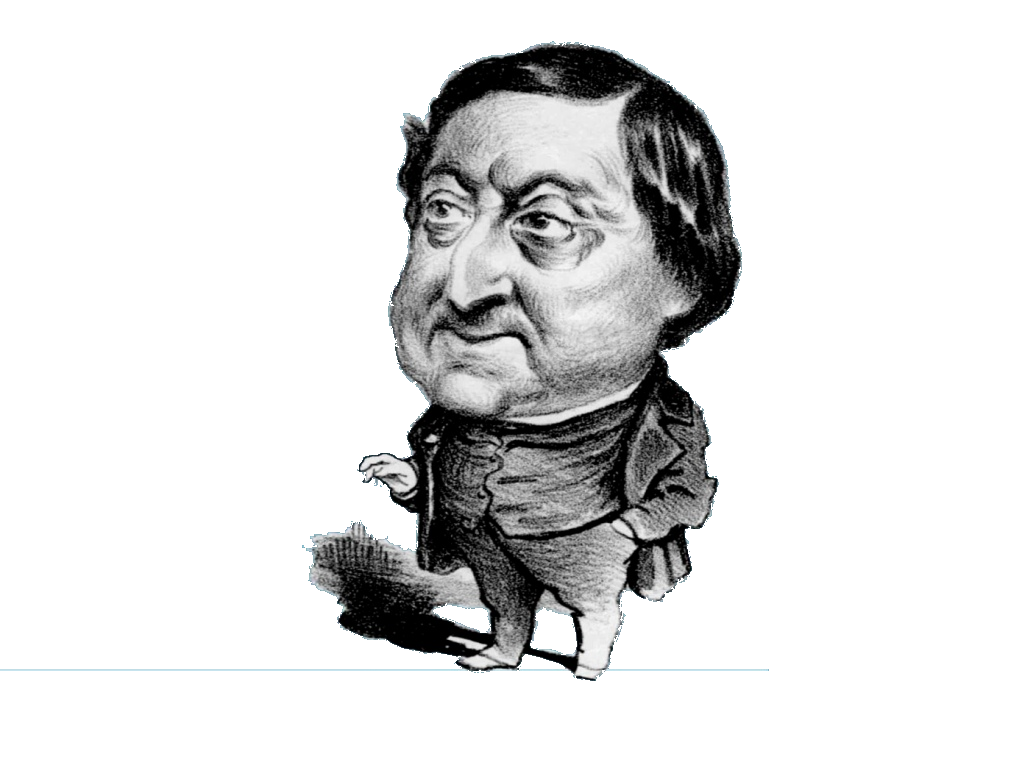 |
|
1 CD -
8.573107 - (p) & (c) 2014
|
|
| PÉCHÉS
DE VIEILLESSE - Volume 6 |
|
|
|
|
|
|
|
| Gioachino ROSSINI
(1791-1868) |
Péchés
de vieillesse - Volume IV "Quatre
mendiants"
|
|
|
|
|
-
No. 1 - Les figues seches: Me voilà -
Bonjour madame |
|
4' 51" |
1 |
|
-
No. 2 - Les amandes: Minuit sonne -
Bonjour madame |
|
5' 00" |
2 |
|
-
No. 3 - Les raisins: A ma petite
perruche *
|
|
5' 28" |
3 |
|
- No. 4 - Les noisettes:
A ma chère Nini |
|
3' 50" |
4 |
|
Péchés de vieillesse
- Volume IV "Quatre hors d'œuvres" |
|
|
|
|
- No. 1 - Les radis
|
|
6' 47" |
5 |
|
- No. 2 - Les anchois:
Thème et variations
|
|
5' 33" |
6 |
|
- No. 3 - Les
cornichons: Introduction |
|
4' 10" |
7 |
|
- No. 4 - Le beurre:
Thème et variations
|
|
8' 47" |
8 |
|
Péchés de vieillesse
- Volume X "Miscellanée pour piano" |
|
|
|
|
- No. 4 - Une bagatelle |
|
1' 22" |
9 |
|
- No. 5 - Mélodie
Italienne, une bagatelle: In nomine
Patris |
|
1' 05" |
10 |
|
Péchés de vieillesse
- Volume VI "Album pour les enfants
dégourdis" |
|
|
|
|
- No. 11 - Etude
ashmatique |
|
6' 25" |
11 |
|
Péchés de vieillesse
- Volume XIV "Altri Péchés de
vieillesse" |
|
|
|
|
- No. 4 - Petite
promenade de Passy à Courbevoie |
|
3' 46" |
12 |
|
- No. 8 - Ritornelle
gothique |
|
1' 29" |
13 |
|
- No. 7 - Tourniquet sur
la gamme chromatique, ascendent et
descendent |
|
3' 58" |
14 |
|
- No. 6 - Encore un peu
de blague |
|
2' 39" |
15 |
|
- No. 5 - Une
réjouissance |
|
3' 03" |
16 |
|
Waltz
in E-Flat Major (1849 version) |
|
2' 14" |
17 |
|
|
|
|
|
Alessandro MARANGONI, pianoforte
and voice*
|
|
|
|
|
|
Luogo
e data di registrazione |
|
Baroque
Hall, Ivrea, Torino (Italia) - 25-26
settembre 2012 |
|
|
Registrazione:
live / studio
|
|
studio |
|
|
Producers |
|
Renato
Campajola & Mario Bertodo |
|
|
Recording
engineers |
|
Renato Campajola
& Mario Bertodo |
|
|
Editors |
|
Renato
Campajola & Mario Bertodo |
|
|
Cover |
|
Paolo
Zeccara |
|
|
Edizione
CD |
|
NAXOS |
8.573107 | (1 CD) | durata 70' 24" |
(p) & (c) 2014 | DDD |
|
|
Note |
|
-
|
|
|
|
|
Gioachino
Antonio Rossini, one of the most
successful and popular operatic
composers of his time, was born
in Pesaro in 1792. His father, a
brass player and later teacher
of the French horn at the
Bologna Accademia, had a modest
career, disturbed by the
political changes of the period
as the French replaced the
Austrians in Northern Italy.
Rossini’s mother was a singer
and as a boy Rossini made his
appearance with his father in
the pit orchestra and from time
to time as a singer with his
mother on stage, going on to
work as a keyboard player in the
opera orchestra.
Rossini’s early studies in music
were with his father and mother,
and with other teachers through
the generosity of rich patrons.
In childhood he had already
started to show ability as a
composer and his experience in
the opera house bore natural
fruit in a remarkable and
meteoric career that began in
1810 with the production of La
cambiale di january in Venice.
There followed a series of
operas, comic and tragic, until
the relatively poor reception of
Semiramide in Venice in 1823
turned Rossini’s attention to
Paris. Under the Bourbon King
Charles X Rossini staged French
versions of earlier works and in
1829 Guillaume Tell. A contract
for further operas came to
nothing when the King was
replaced in the revolution of
1830 by Louis-Philippe, although
eventually, after some six
years, Rossini was able to have
his agreed annuity restored.
With matters settled in France,
in 1836 he returned to Italy and
in spite of ill health concerned
himself with the affairs of the
Liceo Musicale in Bologna. The
revolutionary disturbances there
in 1848, activities with which
he had little sympathy, seemed
to threaten him and his second
wife, Olympe Pélissier, whom he
had married in 1846, after the
death of his first wife, the
singer Isabella Colbran, from
whom he had been legally
separated since 1837. For his
own safety he moved first to
Florence, but in 1855, partly in
a search for better health,
returned to Paris. In that city
and a few years later at his new
villa at Passy he passed the
rest of his life.
Rossini’s last ten years brought
a return to composition,
principally with a series of
pieces described as Péchés de
vieillesse (Sins of Old Age).
Some of these are based on
earlier works, some designed for
performance at the informal
Saturday evenings when he
entertained guests in Paris, and
others simply musical obiter
dicta, as it were, pieces
written as the mood took him.
The Péchés de vieillesse are
included in thirteen volumes,
with the fourth to the eighth
grouped together by Rossini as
‘Un peu de tout. Recueil de 56
morceaux semi-comiques pour le
piano (“Je dédie ces Péchés de
vieillesse aux pianistes de la
4.me classe à la quelle j’ai
l’honneur d’appartenir”) (A
little of everything. Collection
of 56 semi-comic pieces for the
piano: “I dedicate these Sins of
Old Age to pianists of the
fourth class, to which I have
the honour to belong”). Rossini
was unfairly modest about his
abilities as a pianist, which
were, it seems, not
inconsiderable.
The fourth volume of Rossini’s Péchés
de vieillesse has four
items of dessert (mendiants),
figs, almonds, raisins and
hazelnuts, followed by four as hors
d’oeuvres, radishes,
anchovies, gherkins and butter.
Les figues sèches (Me voilà –
Bonjour madame) (Dried
Figs) (Here I am – Good morning,
Madame), greets his wife with a
piece that starts amicably
enough, to be interrupted by
moments of turbulence at the
table. Les amandes (Minuit
sonne – Bonjour madame)
(Almonds) (Midnight sounds –
Good evening, Madam) opens with
the twelve chimes of the bell
that bring midnight, followed by
a waltz and other episodes. Les
raisins (A ma petite Perruche)
(Raisins – To my little
parakeet) is described by
Rossini as a compilation of the
social gifts of his dear
parakeet by his friend and
colleague. The bird betrays
something of a military
background in its own additions
to the score, including commands
to shoulder arms, present arms
and to fire, with the sound of
the drum, and songs of smoking
and drinking, J’ai du bon
tabac (I’ve good tobacco
in my pouch) and Quand je
bois du vin clairet (When
I drink red wine). Dessert ends
with Les noisettes (A
ma chère Nini) (Hazelnuts
– To my dear Nini), for his dog
and with more than a touch of
Chopin. The Quatre hors
d’oeuvres start with
radishes, provoking an operatic
study in a minor key. Les
anchois (Anchovies) is a
theme with a series of
variations of increasing
elaboration, followed by Les
cornichons (Gherkins),
which serves as an introduction
to Le beurre (Butter), a
further set of variations.
The tenth volume has six
miscellaneous piano pieces. Two
of these, both described as Bagatelles
and relatively short, include a
Bagatelle in E flat
major, marked Andante mosso
and Mélodie italienne, In
Nomine Patris, an A flat
major piece suggesting the style
of Schumann. Eleven of the
twelve pieces that make up the
sixth volume are recorded on the
second release (Naxos 8.570766)
of the present series. Included
here is a twelfth piece from the
Album pour les enfants
dégourdis (Album for Smart
Children), the eleventh of the
album, Etude asthmatique
(Asthmatic Study), which, in
spite of its title, leaves
barely a pause for breath in its
rapid progress.
The later volumes of the Péchés
de vieillesse are
collections of various pieces by
Rossini, subsequently assembled
to provide a publishable
continuation of the series. The
various pieces that constitute
the fourteenth volume include Petite
promenade de Passy à
Courbevoie (Little Walk
from Passy to Courbevoie). After
his return to Paris in 1855,
Rossini rented a villa for the
summer at Passy, on the Bois de
Boulogne, and was later to have
a house built there, the place
where he was to die in 1868. The
little walk, from the centre of
Paris to Passy runs, as its
continuing title declares,
through all the keys of the
chromatic scale and is, in a
phrase worthy of Eric Satie, to
be played homéopathiquement
et à la pesarese
(homeopathically and in the
style of Pesaro). A rhythmic and
melodic pattern is repeated in
various keys as the piece
progresses. This is followed by
Ritournelle gothique with
its repeated short ritornello,
to be followed by Tourniquet
sur la gamme chromatique,
ascendante et descendante in
which Rossini explores the
possibilities of a very short
repeated phrase, revolving, as
its title proclaims, through the
ascending and descending
chromatic scale. Encore un
peu de blague (A little
bit more fun) follows a similar
procedure, exploring the
possible chromatic modulations
off a short phrase. Une
réjouissance is a waltz,
starting in A minor and building
to an eventual climax in the
tonic major key.
The Waltz in E flat major,
one of a pair of such pieces, is
dedicated to la carissima Signora
Elena Bandiera Ricci, whom
Rossini describes as his candido
estimatore, his honest
appraiser. The piece is dated
1849, when Rossini had moved
from Bologna to Florence, to
avoid the civil disturbances in
the former city. The identity of
the dedicatee has not been
established.
Keith Anderson
|
|

